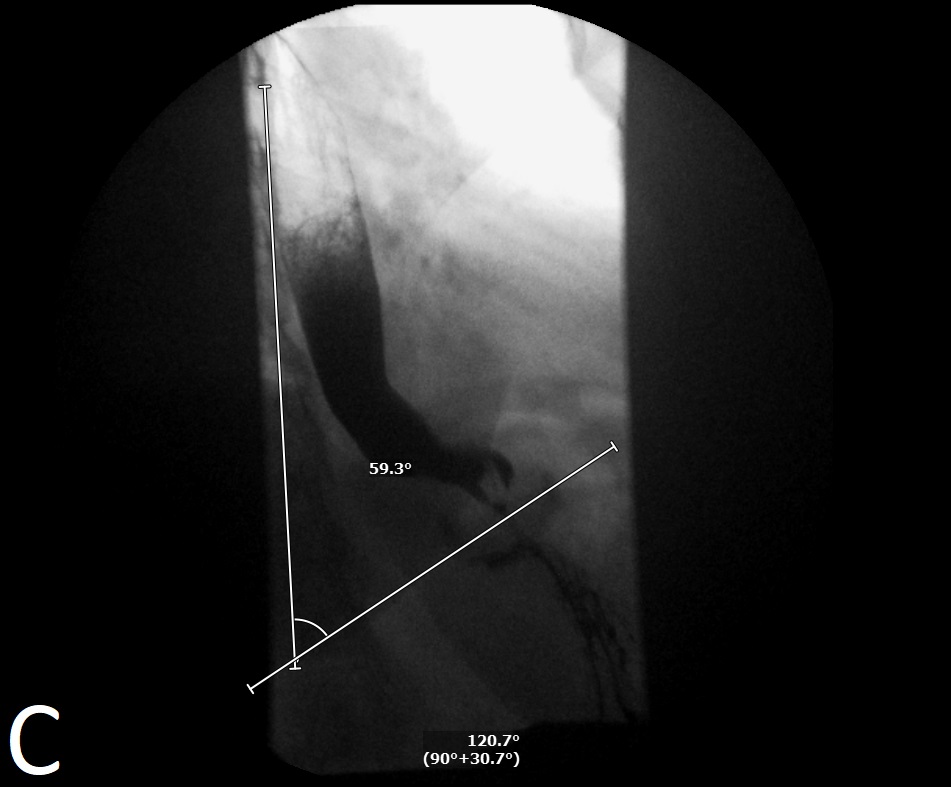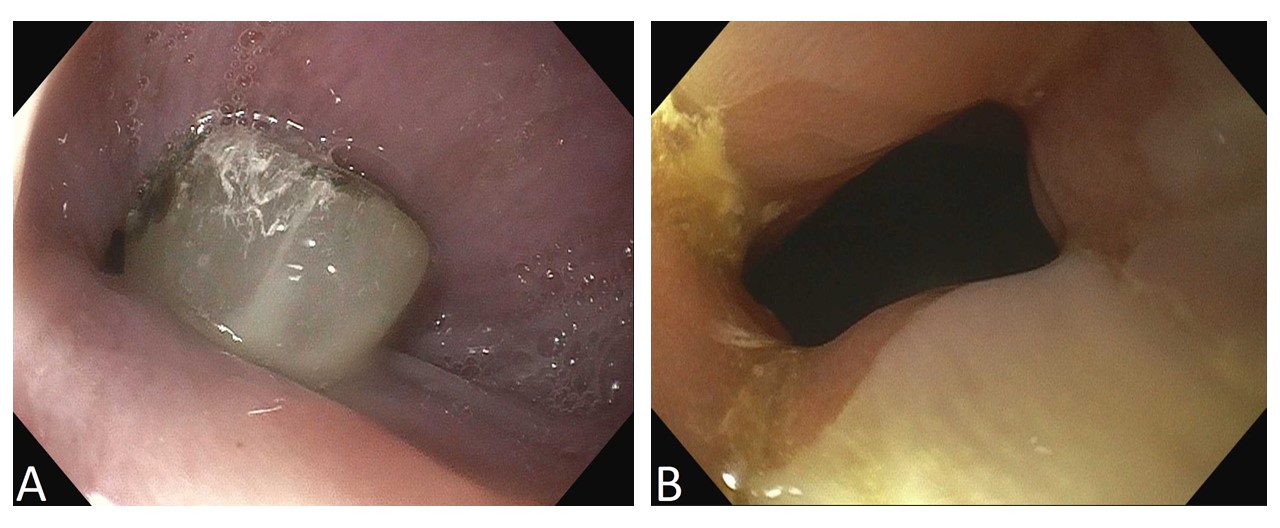Monday Poster Session
Category: Esophagus
P2834 - Clove Encounters: A Case of Garlic Impaction and Gastric Lap-Band Slippage
Monday, October 27, 2025
10:30 AM - 4:00 PM PDT
Location: Exhibit Hall
.jpg)
Luke Stachler, MD
University of Florida College of Medicine
Jacksonville, FL
Presenting Author(s)
Luke Stachler, MD, Laura Suzanne K.. Suarez, MD, Radhika Sharma, DO, Sneh Parekh, DO, Bruno Ribeiro, MD
University of Florida College of Medicine, Jacksonville, FL
Introduction: Impaction of foreign bodies or food boluses can be the first sign of underlying dysphagia. Dysphagia can have a multitude of etiologies ranging from swallowing of oversized boluses and underlying acid reflux to malignancy, lower esophageal sphincter dysfunction, or other structural or luminal deformations or obstructions. Laparoscopic adjustable gastric bands (lap-bands) are devices that can be placed in the upper portion of the stomach, typically just inferior to the gastroesophageal junction, to promote early satiety and encourage weight loss. Due to malpositioning or slippage, lap-bands can cause extrinsic compression of the esophagus. We present a case of a woman with food impaction which revealed an underlying slippage of a lap-band.
Case Description/
Methods: A 51-year-old woman with history of renal disease on peritoneal dialysis, hypertension, hypothyroidism, and lap-band placement placed ten years prior presented to the emergency department due to inability to tolerate food intake four days after eating garlic. Vitals were within normal limits. Labs were consistent with known renal and thyroid disease. Esophagogastroduodenoscopy uncovered a large garlic clove lodged proximal to the z-line (Figure A). After snare removal, repeat visualization revealed cranial slippage of her existing lap-band to the level of the gastroesophageal junction, causing extrinsic compression of the distal esophagus without evidence of esophagitis (Figure B). Esophagram showed a lap-band phi angle of 59 degrees (Figure C). She was able to tolerate an oral diet and was discharged with plans for surgical lap-band removal.
Discussion: Lap-band placement is a minimally invasive bariatric procedure involving the placement of an adjustable band around the upper part of the stomach to create a smaller pouch. Slippage is a rare complication that can ensue in approximately 5-8% of patients and occurs when the lower part of the stomach prolapses cranially, creating a larger upper pouch, and in some instances, obstruction. A strong correlation between erosion and slippage was found if the perigastric surgical technique of insertion was used. Thankfully, our patient did not suffer from this complication. Management of slipped lap-bands can range from band deflation, replacement, and complete removal, as was planned for our patient. Patients with dysphagia should be evaluated closely for both intrinsic and extrinsic causes, especially in those who have a history of prior GI procedure or surgery.

Figure: Figure A: Endoscopic view of obstructing impacted food in the distal esophagus, proximal to the z-line; Figure B: Endoscopic view of obstructed esophageal lumen from slipped gastric lap band

Figure: Figure C: Image from esophagram indicating lap-band phi angle of 59 degrees
Disclosures:
Luke Stachler indicated no relevant financial relationships.
Laura Suzanne Suarez indicated no relevant financial relationships.
Radhika Sharma indicated no relevant financial relationships.
Sneh Parekh indicated no relevant financial relationships.
Bruno Ribeiro indicated no relevant financial relationships.
Luke Stachler, MD, Laura Suzanne K.. Suarez, MD, Radhika Sharma, DO, Sneh Parekh, DO, Bruno Ribeiro, MD. P2834 - Clove Encounters: A Case of Garlic Impaction and Gastric Lap-Band Slippage, ACG 2025 Annual Scientific Meeting Abstracts. Phoenix, AZ: American College of Gastroenterology.
University of Florida College of Medicine, Jacksonville, FL
Introduction: Impaction of foreign bodies or food boluses can be the first sign of underlying dysphagia. Dysphagia can have a multitude of etiologies ranging from swallowing of oversized boluses and underlying acid reflux to malignancy, lower esophageal sphincter dysfunction, or other structural or luminal deformations or obstructions. Laparoscopic adjustable gastric bands (lap-bands) are devices that can be placed in the upper portion of the stomach, typically just inferior to the gastroesophageal junction, to promote early satiety and encourage weight loss. Due to malpositioning or slippage, lap-bands can cause extrinsic compression of the esophagus. We present a case of a woman with food impaction which revealed an underlying slippage of a lap-band.
Case Description/
Methods: A 51-year-old woman with history of renal disease on peritoneal dialysis, hypertension, hypothyroidism, and lap-band placement placed ten years prior presented to the emergency department due to inability to tolerate food intake four days after eating garlic. Vitals were within normal limits. Labs were consistent with known renal and thyroid disease. Esophagogastroduodenoscopy uncovered a large garlic clove lodged proximal to the z-line (Figure A). After snare removal, repeat visualization revealed cranial slippage of her existing lap-band to the level of the gastroesophageal junction, causing extrinsic compression of the distal esophagus without evidence of esophagitis (Figure B). Esophagram showed a lap-band phi angle of 59 degrees (Figure C). She was able to tolerate an oral diet and was discharged with plans for surgical lap-band removal.
Discussion: Lap-band placement is a minimally invasive bariatric procedure involving the placement of an adjustable band around the upper part of the stomach to create a smaller pouch. Slippage is a rare complication that can ensue in approximately 5-8% of patients and occurs when the lower part of the stomach prolapses cranially, creating a larger upper pouch, and in some instances, obstruction. A strong correlation between erosion and slippage was found if the perigastric surgical technique of insertion was used. Thankfully, our patient did not suffer from this complication. Management of slipped lap-bands can range from band deflation, replacement, and complete removal, as was planned for our patient. Patients with dysphagia should be evaluated closely for both intrinsic and extrinsic causes, especially in those who have a history of prior GI procedure or surgery.

Figure: Figure A: Endoscopic view of obstructing impacted food in the distal esophagus, proximal to the z-line; Figure B: Endoscopic view of obstructed esophageal lumen from slipped gastric lap band

Figure: Figure C: Image from esophagram indicating lap-band phi angle of 59 degrees
Disclosures:
Luke Stachler indicated no relevant financial relationships.
Laura Suzanne Suarez indicated no relevant financial relationships.
Radhika Sharma indicated no relevant financial relationships.
Sneh Parekh indicated no relevant financial relationships.
Bruno Ribeiro indicated no relevant financial relationships.
Luke Stachler, MD, Laura Suzanne K.. Suarez, MD, Radhika Sharma, DO, Sneh Parekh, DO, Bruno Ribeiro, MD. P2834 - Clove Encounters: A Case of Garlic Impaction and Gastric Lap-Band Slippage, ACG 2025 Annual Scientific Meeting Abstracts. Phoenix, AZ: American College of Gastroenterology.

